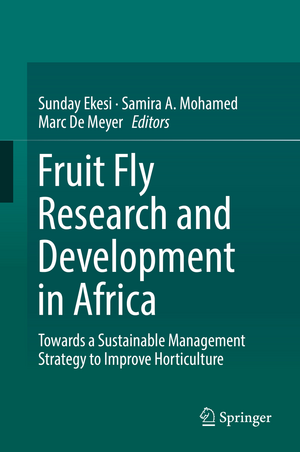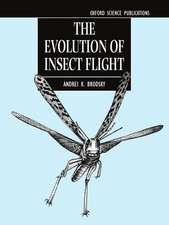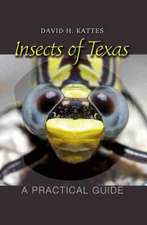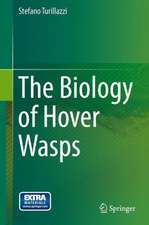Fruit Fly Research and Development in Africa - Towards a Sustainable Management Strategy to Improve Horticulture
Editat de Sunday Ekesi, Samira A. Mohamed, Marc Demeyeren Limba Engleză Hardback – 15 dec 2016
| Toate formatele și edițiile | Preț | Express |
|---|---|---|
| Paperback (1) | 1202.95 lei 38-44 zile | |
| Springer International Publishing – 30 apr 2018 | 1202.95 lei 38-44 zile | |
| Hardback (1) | 776.88 lei 3-5 săpt. | +70.92 lei 4-10 zile |
| Springer International Publishing – 15 dec 2016 | 776.88 lei 3-5 săpt. | +70.92 lei 4-10 zile |
Preț: 776.88 lei
Nou
Puncte Express: 1165
Preț estimativ în valută:
148.70€ • 161.58$ • 124.99£
148.70€ • 161.58$ • 124.99£
Carte disponibilă
Livrare economică 31 martie-14 aprilie
Livrare express 14-20 martie pentru 80.91 lei
Preluare comenzi: 021 569.72.76
Specificații
ISBN-13: 9783319432243
ISBN-10: 3319432249
Pagini: 956
Ilustrații: XX, 778 p. 153 illus., 94 illus. in color.
Dimensiuni: 155 x 235 x 46 mm
Greutate: 1.5 kg
Ediția:1st ed. 2016
Editura: Springer International Publishing
Colecția Springer
Locul publicării:Cham, Switzerland
ISBN-10: 3319432249
Pagini: 956
Ilustrații: XX, 778 p. 153 illus., 94 illus. in color.
Dimensiuni: 155 x 235 x 46 mm
Greutate: 1.5 kg
Ediția:1st ed. 2016
Editura: Springer International Publishing
Colecția Springer
Locul publicării:Cham, Switzerland
Cuprins
Section A. Biology and Ecology
Chapter 1: Taxonomy and systematics of African fruit flies – M. De Meyer
Chapter 2. Identification tools for African frugivorous fruit flies (Diptera: Tephritidae) – M. Virgilio
Chapter 3: Population genetics of African frugivorous fruit flies (Diptera: Tephritidae): current knowledge and future perspectives – M. Virgilio and H. Delatte
Chapter 4: Role of microsatellite markers in molecular population genetics of fruit flies with emphasis on the Bactrocera dorsalis invasion of Africa – F. Khamis and A. Malacrida
Chapter 5: Fruit fly species composition, distribution and host plants with emphasis on mango-infesting species – I. Rwomushana and C. M. Tanga
Chapter 6: Fruit fly species composition, distribution and host plants with emphasis on vegetable-infesting species – C. M. Tanga and I. Rwomushana
Chapter 7: Exotic invasive fruit flies (Diptera: Tephritidae): in and out of Africa – M. De Meyer and S. Ekesi
Chapter 8: Feeding and mating behaviour of African fruit flies – A. Manrakhan
Chapter 9: Chemical ecology of African tephritid fruit flies – A. T. Fombong, D. Kachigamba and B. Torto
Chapter 10: Fruit fly nutrition, rearing and quality control – S. A. Mohamed, F. K. Khamis and C. M. Tanga
Chapter 11: The ontological modelling of fruit fly control and management knowledge - C. C. Kiptoo, A. Gerber and A. Van der Merwe
Section B. Pre-harvest and Post-harvest Management Measures
Chapter 12: Detection and monitoring of fruit flies in Africa – A. Manrakhan
Chapter 13: Baiting and male annihilation techniques for fruit fly suppression in African – S. Ekesi
Chapter 14: Waste brewer’s yeast as an alternative source of protein for use as a bait in the management of tephritid fruit flies – S. Ekesi and C. M. Tanga
Chapter 15: Development and application of mycoinsecticides for the management of fruit flies in Africa – N. K. Maniania and S. Ekesi
Chapter 16: In and out of Africa: Parasitoids used for biological control of fruit flies – S. A. Mohamed, M. M. Ramadan and S. Ekesi
Chapter 17: From behavioural studies to field application: improving biological control strategies by integrating laboratory results into field experiments – K. Merkel, V. Migani, S. Ekesi and T.S. Hoffmeister
Chapter 18: The use of weaver ants in the management of fruit flies in Africa - J.-F. Vayssières, J. Offenberg, A. Sinzogan, A. Adandonon, R. Wargui, F. Anato, H. Y. Houngbo, I. Ouagoussounon, L. Diamé, S. Quilici, J.-Y. Rey, G. Goergen, M. De Meyer and P. Van Mele.
Chapter 19: Sterile Insect Technique (SIT) for fruit fly control – The South African experience – B. N. Barnes
Chapter 20: Cold and heat treatment technologies for post-harvest control of fruit flies in Africa
– T. G. Grout
Chapter 21: Photographs of some native and exotic fruit fly species in Africa and their parasitoids
Section C. Country Specific Action Programmes and Case Studies
Chapter 22: Integrated management of fruit flies – case studies from Uganda – B. E. Isabirye, C.K. Nankinga, A. Mayamba, A. M. Akol, I. Rwomushana
Chapter 23: Integrated management of fruit flies – case studies from Tanzania – M. Mwatawala
Chapter 24: Integrated management of fruit flies – case studies from Mozambique – D. R. Cugala, M. De Meyer and L. J. Canhanga
Chapter 25: Integrated management of fruit flies – case studies from Nigeria – V. Umeh and D. Onukwu
Chapter 26: Release, establishment and spread of the natural enemy Fopius arisanus (Hymenoptera: Braconidae) for control of the invasive oriental fruit fly Bactrocera dorsalis (Diptera: Tephritidae) in Benin, West Africa - D. Gnanvossou, R. Hanna, A. H. Bokonon-Ganta, S. Ekesi and S. A. Mohamed
Chapter 27: Integrated management of fruit flies – case studies from Ghana – M. K. Billah and D. D. Wilson
Chapter 28: Integrated management of fruit flies – case studies from the Indian Ocean Islands – P. Sookar and J.-P. Deguine
Section D. Experiences from actions programmes outside Africa
Chapter 29: Area-wide management of fruit flies (Diptera: Tephritidae) in Hawaii - R. I. Vargas, J. C. Piñero, L. Leblanc, N. C. Manoukis and R. F. L. Mau
Chapter 30: Management of fruit flies in Mexico – P. Liedo
Chapter 31: Overview of the programme to eradicate Bactrocera carambolae in South America – D. Midgarden, A. van Sauers-Muller, M. J. Signoretti Godoy and J-F Vayssières
Chapter 32: Systems approaches for managing the phytosanitary risk of trading in commodities that are hosts of fruit flies – E. B. Jang
Section E. Socioeconomic Impact Assessment
Chapter 33: Economic impact of integrated pest management strategies for the suppression of mango-infesting fruit fly species in Africa - B. W. Muriithi, G. Diiro, H. Affognon and S. Ekesi
Section F. Lessons Learnt and Future Perspectives
Chapter 34: Lessons learnt and future perspectives – S. Ekesi, S. A. Mohamed and M. De Meyer
Notă biografică
Editors:
S. Ekesi, S.A. Mohamed & M. De Meyer
Textul de pe ultima copertă
Horticultural sector presents many opportunities for economic development and improving livelihood of growers but several factors constrain production and limit the potential for trade of fruits and vegetables. Tephritid fruit flies constitute a major constraint. They cause enormous losses through direct feeding damage and loss of market opportunities through imposition of quarantine restrictions by importing countries to prevent entry and their establishment. In Africa, several native (Ceratitis and Dacus spp) and exotic (Bactrocera and Zeugodacus spp.) species inflict considerable losses to horticulture causing losses ranging from 30-90%. Over the past 10 years of R&D, extensive information has been generated on bioecology and management of several native and exotic fruit flies in Africa. While several specific reviews have addressed various aspects of the biology, ecology and management of economically important tephritid fruit flies; coverage of African native species has been limited largely to Bactrocera oleae and Ceratitis capitata – which are not economically important species in many Africa countries. Indeed, no book exist that have explicitly addressed economically important African fruit flies and none of the various reviews, have specifically focused on the status of the bioecology, economic impact and management of exotic and native fruit flies – including several potentially invasive Dacus species attacking vegetables - in Africa. This book consolidates this status of knowledge and socio-economic impact of various intervention techniques that are currently being applied across Africa. The timing of the book is especially pertinent due to the changing fruit fly landscape in Africa – caused by arrivals of the highly destructive alien invasives (Bactrocera dorsalis, B. zonata, and B. latifrons) - and the priorities African countries have placed recently on export of fruits and vegetables to international markets. This is an important reference material for researchers, academics and students that are keen at improving horticulture and enhancing food and nutrition security in Africa and beyond.
Caracteristici
Comprehensive appraisal of fruit fly problems and solutions in Africa from taxonomy, to bioecology and management with powerful color plates of native and invasive species
Powerful focus on management and economic impact assessment
All-inclusive assessment of perspective for the future and R&D that are necessary to feed into current management methods
Powerful focus on management and economic impact assessment
All-inclusive assessment of perspective for the future and R&D that are necessary to feed into current management methods











